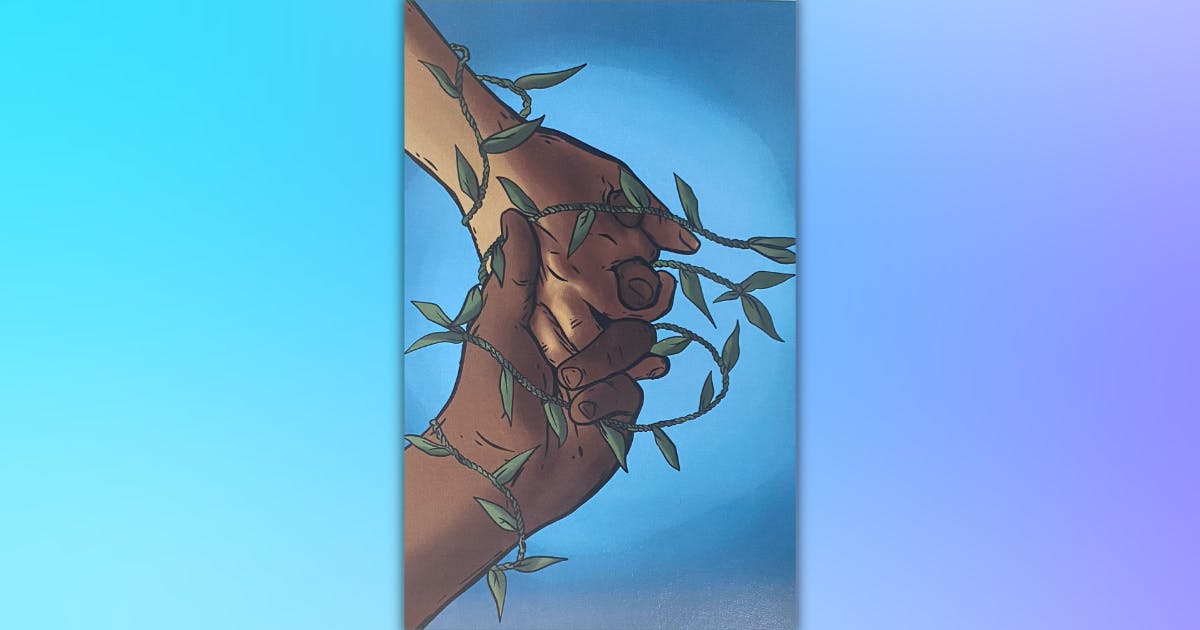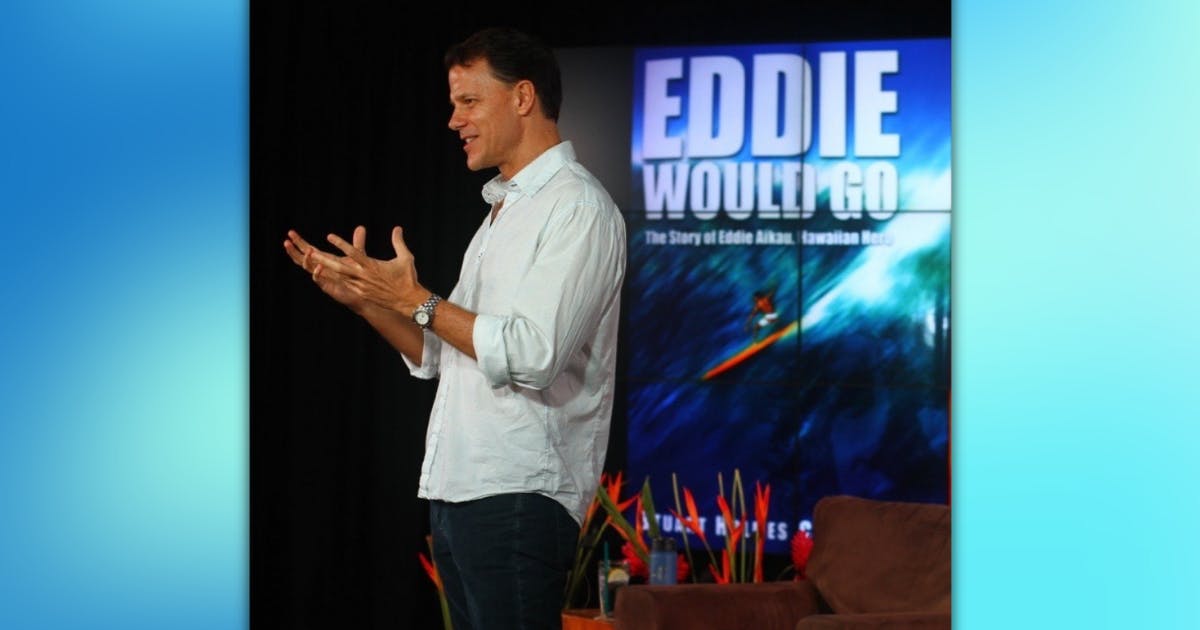Contributed by: Pualani Enos
What distinguishes Hawaiian Leadership from all others is the potential of connection, and the power of pilina.

Photo from Pualani Enos, courtesy Small Town * Big Art
Representing one Hawaiian’s experience of diaspora resulting from the overthrow of Queen Liliʻuokalani in 1893, I have been able to return to Hawaiʻi and learn what it means to be Hawaiian through hula, paddling, and kula kaiapuni (Hawaiian Language Immersion School). As a nonprofit director, educator, researcher, and writer, formally trained in western knowledge, the art of lei making has been a formative and continuous part of my learning journey and the practice of what it means to care for the place, living things, and people in my biosphere of Maui nui and through networks across Hawaiʻi nei.
Kumu Hula Auntie Maʻiki Aiu Lake’s teaching that “hula is life,” beautifully described in the book of the same name, has bared out for me and for other leaders who I admire, in how the worldview, practices, and lived experiences within hula serve us to navigate all matters of leadership. The intention, purpose, and act of lei making and all that it entails offers awareness, insight, and navigation tools to build connections that are generative and enduring so that we may restore balance where there is none—to join what has been fractured into a unified whole. As a leader, my greatest honor has been weaving together the talents of those who may not gain your attention alone, but when woven with very different talents of others, allows all to shine with passion fueled by collective purpose to shine new light, to achieve what was previously unimaginable.
Creating lei fuels my ability to create in professional contexts that are complex and confounding. Since no change is possible without gratitude, I share this piece of art that sparked what culminated in my first lei submission to Maui Historical Society’s Lei Contest. I share my letter of gratitude which I think best describes my journey and you can decide what, if any, of it relates to your own creativity and leadership. Not all aspects of this letter will make sense to any one person, but as my Hawaiian sources have taught me, I ask you to “empty” and offer grace in my attempt to share this breath of my life, letting whatever settles with you do its job knowing that what is not meant for you might be meant for someone else.
May 1, 2022
Dear Lei Contest Judges and Board of Directors of Maui Historical Society:
We, ‘Ohana Enos Dunn, are so honored to be a part of Lei Day Heritage Festival 2022 hosted in Wailuku town by the beloved Maui Historical Society, at Hale Hōʻikeʻike. We write to thank you for this annual opportunity to practice ‘ike kūpuna and mālama ʻāina as a family. The lei we present on this day, May 1, 2022, is to honor the majesty of our place, the mauna, the kai, the uplands and lowlands, the beaches into the deepest ocean, the flora and fauna, and all the waters that flow from the tip top of our mauna and give life and abundance miles out to sea. We thank you for your time, mana, and aloha which makes this experience possible for our community.
This lei is our attempt to recognize and be recognized by our Akua, nāʻaumākua, nā aliʻi o Maui, nā kūpuna, nā mākua, a me ka lehulehu. Once our lei making is complete, we will be visiting ʻĪao and the gravesites, original and contemporary, of our kūpuna, Edmund Kahikiula Enos and Maraea Keliʻimakuaole Kaulia Enos, in gratitude for their contributions and making our ‘ohana possible. In honor of future generations, we also celebrate the 8th birthday of our nephew and cousin Kalakahikiola Galon.
The laʻi and kukui leaf represents the foundation of wellness and enlightenment which began for us in Waikapu and ʻĪao Valley. The kaunaʻoa represents our connection to the sea and acknowledges Lānaʻi. The hina is to honor Pele and our ‘ohana on Molokaʻi. The crown flower recognizes and honors our last reigning monarch, Queen Liliʻuokalani. The limu is in honor of Auntie Edith Kanakaʻole, a reminder of the precious treasures of the ʻāina and ke kai that not only feed us in the present, but fed our kūpuna, and ensure perpetuation of all life into the future. We are also so grateful to Auntie Nanifay, who made this lesson visceral and concrete by taking us to the shores of Kīhei and Waiehu when our keiki were babies, and I was in my infant stages of my cultural knowing and true connection to my place. Now, Auntie laments and reminds us of the abundance of limu in our shallow waters and our shorelines, that is so scarce that the younger generations do not know what it looks like, how it smells, or the bounty it provides in pohole salad, when the rare surviving bounty of mauka meets makai, through the knowing and loving hands of our kūpuna. While we attempted to learn how to make a ti rose for Maui, since roselani is too delicate to use for lei, it hasn’t come yet. The omission of this ti leaf rose signifies our ahonui to keep learning so that it can be included in a future lei. Songs: I know that song, listen, feel it, watch the videos, take it in. Ka Uluwehi O Ke Kai, Lei Ana O Maui, Kuʻu Home O Kahaluʻu
The lauaʻe in the lei is a tribute and gratitude to our hula sanctuary and place of eternal learning, Hālau Makana Aloha O Ka Lauaʻe, under the direction our beloved Kumu Sissy Lake-Farm who so generously, with perseverance and grace, shares her Hula genealogy with all of us. In keeping with this gratitude, after Lei Day Celebration, we will be placing this lei at the gravesite of Kumu John Keolamakaʻāinanakalāhuiokalaniokamehamehaʻekolu Lake (1937–2008)—our first connection to oli and hula, and paddling— through his daughter, Kumu Sissy and hānai son, Kumu Kaponoʻai Molitau through Nā Hanona Kūlike ʻO Piʻilani and Hawaiian Canoe Club. Our gratitude and aloha for Papa Lake and Aunty Barbara is unmeasured.
This lei is our ‘ohana’s best effort to hōʻike what we have learned about our extraordinary culture, people, and place. We appreciate all the teachers, sources of ‘ike who are passing on the lessons, history, and practices of previous generations. Teachers come in many forms and we wish to recognize the following ‘ohana and organizations from Nā Wai ʻEhā for their ‘ike relating to lei making and aloha ʻāina:
- Nā ʻOhana: Ahsau, Atay, Awo, Balidoy, Bailey, Garmon Kanakaʻole, Eckart-Dodd, Galon, Hau, Lake-Farm, Lindsey, Lum, Mejia, Molitau, Kahakalau, Kahalekulu, Kekauoha-Shultz, Maunapau, Pelligrino, Richardson, Robinson, and Tanaka
- Nā Hui: ʻE Kupaku Ka ‘Āina, Maui Hui Mālama, Kaʻehu, Kula Kaiapuni O Maui, Ke Kula ʻO Piʻilani, Laeʻula O Kai Canoe Club, Maui Cultural Lands, Hawaiʻi Islands Land Trust, Nā Koa Manu Conservation, Puʻukukui Watershed Preserve, and Queen Liliʻuokalani Trust
This lei represents our learning over the past 20 years from so many exceptional people and gifted teachers. We have and continue to learn when, where, how, and what to gather; how to clean, store, and prep; how to plan and haku a lei; how to preserve it and bring it back to the earth; and how to restore and revitalize those places that provide. Through this process, we learn from our sources, past and present, to perpetuate a mindset that supports a thriving, enriching, and sustainable life for future generations. We have found that all aspects of lei making, for the variety of reasons we make lei, provide the practice and content of being better humans, better family members, and we hope, better community members. From our sources, Hawaiian and citizens of Hawaiʻi, we strive to learn that beauty is not limited to perfection, the standards of the powers that be, or what has already been created; it is a living force, a mana of healing and oneness. Fine art is the divine force that comes through us, a tangible expression from within our naʻau and heart, that enables us to heal ourselves and others. The lei is kino lau of our spiritual world throughout the natural world. How blessed we are to be able to know, embrace, and live our Hawaiian ways and epistemology! Mahalo nui for being a center stage of this learning.
This lei represents our gratitude for our many blessings, not only through the ‘ike and skills we have acquired but in the blessings of our kino. Our ability to travel across our island, thankful for our legs that carry us to sacred places of our aliʻi and ancestors, thankful for our hands and eyes that enable us to gather. Thankful for the air we breathe and fresh water to drink when we get hot and thirsty. We recognize that not all humans on this earth or even Hawaiians are able to do these things and this lei is in their honor; we see you and you live in our lei as well.
Mahalo to Hale Hōʻikeʻike at the Bailey House, and Maui Historical Society for the perpetuation of history, art, and community across Maui nei. Mahalo to Small Town * Big Town Art for the safe space, inspiration, and aloha to tell our stories and listen to others. Most importantly, you maintain and build new platforms that inspire us to create our own expression of those stories as we carry on with the steadfastness of our ancestors, our individual and collective learning, and spiritual journeys.
Me ke aloha a me ka haʻahaʻa,
Hon. Christopher Dunn & Pualani Enos
Mahealani Dunn, Oliver Keahi Dunn, and Dylan Kaʻiwa Dunn
Omidyar Fellow Stuart Coleman tells how after years of having two separate passions, his love for surfing and writing finally collided like waves to share an inspirational story.
